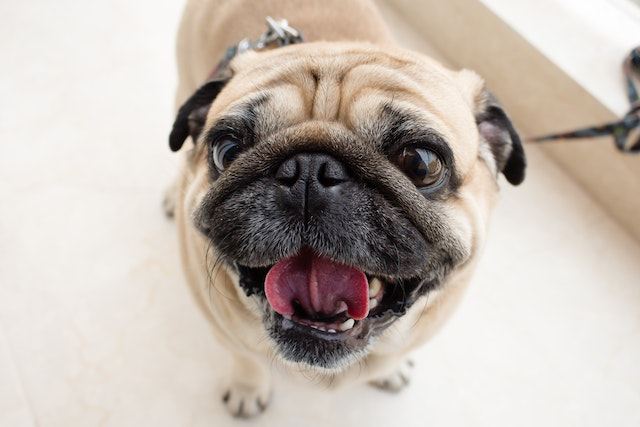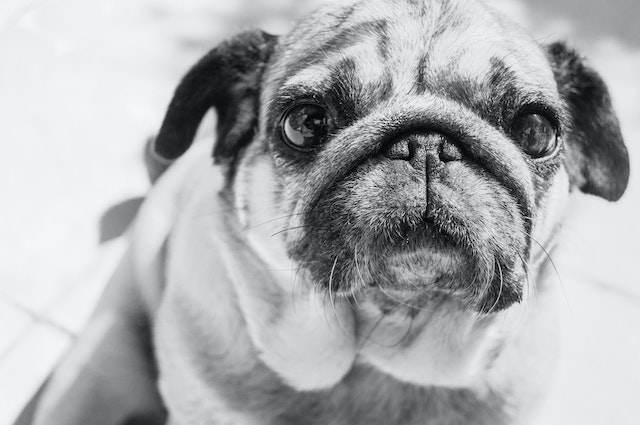11 Most Common Pug Health Problems Explained

Let’s discuss pug health problems in detail…
Pugs are prone to specific health issues that require extra care and attention. In this short blog post, we’ll be discussing some of the most common pug health problems you should be aware of.
So, grab a cup of coffee and get ready to learn how to keep your pug happy and healthy!
Pug Health Problems
Pugs are prone to a number of health problems due to their breeding history, including eye problems, breathing difficulties, and skin allergies.
Their squashed faces and short muzzles can cause respiratory issues, and their wrinkles can lead to skin irritation and infections.
Pug owners should be aware of these potential health issues and take steps to ensure their pets receive appropriate care.
Let’s dig deeper…
Here are some of the most common pug health problems:
1. Brachycephalic Airway Syndrome (BAS)

Brachycephalic Airway Syndrome (BAS) is a condition that affects many dog breeds, including pugs, which have flattened faces, shortened snouts, and narrowed nostrils. This condition results in a restriction of the dog’s airway, causing breathing difficulties and decreased oxygen supply to the body.
Causes
The primary cause of BAS is genetics. The pug’s flat face and shortened snout are the result of a genetic mutation, that affects the shape of the bones in their skull, leading to the narrowing of the airway. Other factors that can contribute to BAS include obesity, age, and underlying respiratory tract infections.
Signs
Pugs with BAS may display symptoms such as noisy breathing, coughing, gagging, snorting, exercise intolerance, and fatigue. They may also experience fainting, labored breathing, and blue tongue or gums, especially during exertion or excitement.
Prevention
The best way to prevent BAS in pugs is to choose a healthy breeding stock that has no history of the condition. Regular exercise and a healthy diet can also help prevent obesity, which is a risk factor for BAS. Avoid exposing pugs to second-hand smoke and environmental pollutants, as they can aggravate symptoms of BAS.
Treatment
For severe cases of BAS in pugs, surgery may be necessary to widen the airway and make breathing easier. Other treatment options may include medications such as corticosteroids or bronchodilators, as well as oxygen therapy. Additionally, providing a stress-free environment and keeping the pug in a cool and ventilated area can help alleviate symptoms.
2. Eye Problems (Corneal Ulcers, Dry Eye, Proptosis)
Eye problems are common in pugs, and some of the most common ones include corneal ulcers, dry eye, and proptosis. These issues can lead to discomfort, irritation, and even vision loss if not appropriately managed.
How it Occurs
Corneal ulcers occur when there is damage to the cornea, which is the clear outer layer of the eye. Dry eye, also known as Keratoconjunctivitis sicca, is a condition that occurs when there is a lack of moisture in the eye, leading to dryness and irritation. Proptosis, on the other hand, occurs when the eyeball is displaced forward out of the eye socket.
Causes
Corneal ulcers can be caused by factors such as eye infections, trauma, or scratches to the eye. Dry eye occurs when the glands that produce tears do not function correctly, leading to inadequate tear production. Moreover, Proptosis is commonly caused by facial trauma resulting from road traffic accidents or other incidents.
Signs
Common signs of these eye problems in pugs include redness, discharge, cloudiness of the eye, squinting, rubbing of the eye, and difficulty opening the eye. In severe cases, there may be eye swelling, protrusion of the eye, and vision loss.
Prevention
While it may not be possible to prevent these eye issues entirely, steps can be taken to minimize the risk. Regular check-ups with a veterinarian can help detect any eye problems early before they become severe. Additionally, pugs’ eyes should be kept clean and free of irritants such as dust and hair.
Treatment
Treatment for eye problems in pugs will depend on the type and severity of the condition. Treatment options may include medications such as eye drops and antibiotics, surgery, or a combination of both. It is essential to consult a veterinarian if you notice any concerning symptoms in your pug’s eyes.
3. Dental Issues
Dental issues are one of the most common health problems in pugs. According to VCA Animal Hospital, dental disease is one of the most common medical conditions seen by veterinarians. Pugs, being a brachycephalic breed, are prone to developing dental issues due to their short snouts.
How it occurs
Dental issues in pugs occur when there is an accumulation of plaque and tartar on their teeth, which can lead to periodontal disease. If left untreated, periodontal disease can result in tooth loss, gum inflammation, and infection.
Causes
Pugs are prone to developing dental issues due to their short snouts, which can result in overcrowding or misaligned teeth, making it difficult for them to chew adequately. Additionally, their tendency to eat soft diets can contribute to the development of dental problems.
Signs
Signs of dental issues in pugs include bad breath, red and swollen gums, loose or missing teeth, drooling, and difficulty chewing.
Prevention
Prevention of dental issues in pugs involves regular dental check-ups with a veterinarian, feeding them hard and crunchy food instead of soft food, providing them with chew toys appropriate for their age, and regular brushing of their teeth at home.
Treatment
Treatment for dental issues in pugs may involve dental cleaning, extraction of teeth that are beyond repair, and in severe cases, surgery. Pain medication and antibiotics may also be prescribed to manage any discomfort and prevent infection.
Learn more about pug dental care.
4. Pug Dog Encephalitis (PDE)

Pug Dog Encephalitis (PDE) is a neurological disease that affects pugs. It is one of the most common and serious health problems that pugs face. PDE is a progressive disease that affects the central nervous system and causes inflammation of the brain. It ultimately leads to the death of the pug.
Causes
The exact cause of PDE is unknown, but it is assumed to be a combination of genetic and environmental factors. It is believed that PDE may occur due to an autoimmune or an allergic reaction.
Signs and Symptoms
The initial symptoms of PDE in pugs may include seizures, loss of balance, and circling. The dog may also show signs of depression, lethargy, and a lack of coordination. As the disease progresses, other symptoms such as blindness, deafness, and paralysis may develop.
Prevention
As the cause of PDE in pugs is not fully understood, prevention is difficult. However, early detection and supportive care can help to improve the quality of life for the dog.
Treatment
There is currently no cure for PDE. Treatment is usually aimed at managing the symptoms and providing supportive care. Anti-seizure medication, immunosuppressive therapy, and supportive care may be administered to alleviate the symptoms.
It is essential to regularly take your pug for check-ups and contact a veterinarian immediately when you notice any signs of PDE.
5. Hip Dysplasia
Hip dysplasia is a common health problem that affects pugs. It is a hereditary condition where the hip joint doesn’t form properly. This leads to a malformed hip joint that eventually leads to osteoarthritis (OA). As a result, affected pugs experience pain and mobility issues.
Causes
Hip dysplasia is caused by genetic factors, but other factors such as poor nutrition, rapid growth, and excessive exercise can exacerbate the condition. Overweight pugs are also at risk of hip dysplasia.
Signs
The most common signs of hip dysplasia in pugs include difficulty standing up, walking, climbing stairs, or jumping, stiffness in the hind legs, lameness, reduced range of motion, and reluctance to play or exercise. Some pugs may also display a bunny-hopping gait or swaying of the hindquarters.
Prevention
Prevention involves measures such as avoiding overfeeding, managing the pug’s weight, providing low-impact exercises to build strength and flexibility, ensuring a well-balanced diet, and avoiding over-exercising.
Treatment
The treatment options for hip dysplasia in pugs vary depending on the severity of the condition. Conservative treatments include weight management, physical therapy, and pain management, while surgical interventions such as a total hip replacement or Femoral Head and Neck Excision (FHNE) may be necessary for advanced cases.
6. Patellar Luxation
Patellar luxation is one of the most common health problems in pugs and occurs when the kneecap or patella is dislocated from its normal position in the groove of the thigh bone. The condition can affect one or both legs and can range from mild to severe, causing pain and discomfort for the affected dog.
Causes and Signs
Patellar luxation in pugs can be caused by a variety of factors, including genetics, injury, or muscle weakness. The condition is more common in smaller dog breeds, including pugs, due to their anatomy and body structure. Signs of patellar luxation may include limping or favoring one leg, unwillingness to jump or climb stairs, and occasional skipping or hopping on one or both legs.
Prevention and Treatment
Prevention measures for patellar luxation in pugs include maintaining a healthy weight, preventing injuries or falls, and avoiding over-exercise. Treatment options depend on the severity of the condition, and in mild cases, rest and pain management may be sufficient. In more severe cases, surgery may be necessary to realign the kneecap and strengthen the surrounding muscles.
7. Ear Infections
Ear infections are one of the most common health problems experienced by Pugs, according to a study by Primary Veterinary Care in the UK. Ear infections in Pugs can be very uncomfortable and painful for the dog, and if left untreated, the infection can lead to serious complications such as hearing loss.
Causes
Ear infections in Pugs are usually caused by bacteria or yeast. One common cause of ear infections in Pugs is allergies. Pollen, mold, dust, food, and flea bites are some of the allergens that can cause ear infections. Another cause is water that gets trapped in the ear canal, which can create a favorable environment for bacteria and yeast to thrive.
Signs
Some signs that your Pug may have an ear infection include head shaking, ear scratching, foul-smelling discharge, redness or swelling of the ear canal, and sensitivity to touch around the ear area.
Prevention
Preventing ear infections in Pugs is doable by keeping their ears clean and dry, especially after swimming or bathing. Also, regular ear checks can help you spot any early signs of ear infections so you can act quickly and prevent the situation from getting worse.
Treatment
It is essential to have your Pug checked out by a veterinarian if you suspect it has an ear infection. Your vet may take a swab to identify the type of infection present and prescribe medication, which will depend on the infection type. Also, mild infections are usually treated with eardrops, while more severe infections may require oral antibiotics.
8. Heat Stroke
Pugs are highly sensitive to heat due to their compromised breathing ability and inability to regulate body temperature efficiently. Heat stroke is a serious condition that can be life-threatening if not addressed promptly.
Causes
Heat stroke in Pugs is primarily caused by excessive heat exposure, high humidity, and inadequate ventilation.
Signs
Watch for symptoms such as excessive panting, drooling, rapid breathing, weakness, collapse, or vomiting. Pugs with heat stroke may exhibit signs of distress and struggle to cool down.
Prevention
Avoid exposing your Pug to extreme heat, especially during the hot summer months. Provide ample shade and fresh water at all times. Never leave your Pug in a parked car, as temperatures can rapidly rise, leading to heat stroke.
Treatment
If you suspect heat stroke, immediately move your Pug to a cooler area, offer water, and use cool towels or a fan to lower their body temperature gradually. Seek veterinary assistance promptly if symptoms persist, as heat stroke can have severe consequences and requires medical intervention.
Learn more about pug shaking.
9. Obesity

Pugs have a tendency to gain weight easily, which can lead to a range of health issues, including joint problems, heart disease, and breathing difficulties.
Causes
Overfeeding, lack of exercise, and genetic factors can contribute to obesity in Pugs.
Signs
Assess your Pug’s body condition regularly. If you can’t feel their ribs or notice excessive weight gain, it’s time to address the issue. Pugs with obesity may exhibit decreased stamina, difficulty breathing, and reduced mobility.
Prevention
Provide a balanced diet, portion control, and regular exercise to maintain a healthy weight for your Pug. Avoid overfeeding and limit treats to prevent excessive calorie intake.
Treatment
If your Pug is overweight or obese, your veterinarian will guide you in adjusting their diet, increasing physical activity, and following a weight management plan. Gradual weight loss is essential to prevent complications and improve overall health.
10. Skin Fold Dermatitis
Skin Fold Dermatitis, also known as Intertrigo, is a common dermatological problem in Pugs that occurs due to folds of skin rubbing against each other and trapping moisture, dirt, and bacteria. This skin condition is mostly observed in areas where skin folds are prominent, such as the face, tail, and armpits.
Causes
Skin Fold Dermatitis in Pugs can be caused by various factors, including obesity, allergies, and infections. As Pugs have numerous folds of skin, these areas create a breeding ground for bacterial growth and aid in the development of dermatitis.
Signs
The most common symptoms of Skin Fold Dermatitis in Pugs include redness, inflammation, and irritation of the affected area. You may also notice discharge, a foul odor, and crusting of the skin around the folds.
Prevention and Treatment
Regular cleaning and proper hygiene can prevent Skin Fold Dermatitis in Pugs. Ensure that the folds are dry, clean, and free of dirt and bacteria. You can clean the folds using a clean, damp cloth or wipes designed for dogs. Dry the folds completely after cleaning to prevent reoccurrence of the problem. If your Pug suffers from chronic skin problems, it is advisable to consult with a veterinarian who may prescribe topical or oral medication based on the severity of the condition.
Learn more about why pugs smell.
11. Cardiac Disorders (Heart Murmurs, Mitral Valve Disease)
Heart murmurs and mitral valve disease are both conditions that affect the heart’s functioning in pugs. They occur when the heart’s valves do not work properly and do not allow proper blood flow. As a result, the heart has to work harder to pump blood, which can ultimately lead to heart failure in pugs.
Causes
Cardiac disorders like heart murmurs and mitral valve disease can be congenital or acquired. Congenital heart diseases result from genetic defects, while acquired heart diseases occur as a result of infections, environmental factors, or aging. In pugs, mitral valve disease is more commonly acquired than congenital. Other factors that can increase a pug’s risk of developing cardiac disorders include obesity, advancing age, and poor diet.
Signs
Common signs of cardiac disorders in pugs include coughing, difficulty breathing, exercise intolerance, and fainting. In addition, pugs with cardiac disorders may show signs of fatigue, weakness, and reduced appetite. Sometimes, these symptoms may not appear until the condition has progressed significantly.
Prevention
Preventing cardiac disorders in pugs can be done by maintaining a healthy lifestyle for the dog. This includes feeding the dog a balanced and healthy diet, maintaining an appropriate weight, regular exercise, and regular veterinary check-ups. Pugs should also be screened for congenital heart defects at an early age.
Treatment
The treatment of cardiac disorders in pugs depends on the specific condition and its severity. Treatment options range from medication to surgical intervention. For example, in cases of mitral valve disease, medication can be used to manage the symptoms and prolong the dog’s life. However, severe cases may require surgery to repair or replace the mitral valve.
Learn more about identifying a sick pug.
How to avoid pug health problems

Here are some common ways to avoid pug health problems:
1. Regular Vet Visits
Regular visits to the veterinarian for check-ups and preventive care can help identify any potential health issues early on and prevent them from becoming more serious. It’s recommended that you take your pug to the vet at least once a year for a check-up.
2. Feeding a Healthy Diet
Feeding your pug a healthy and balanced diet is essential to keep them healthy. Ensure that the diet is adequately balanced with all essential nutrients, including proteins, carbohydrates, and vitamins.
3. Maintain a Healthy Weight
Maintaining a healthy weight is important for your Pug’s overall health. Obesity puts your pug at risk for various health issues such as heart disease, diabetes, and joint problems.
4. Dental Care
Dental problems can lead to other health problems, so it’s crucial to keep your pug’s teeth clean. Regular teeth cleaning and dental check-ups can help prevent dental problems.
5. Exercise
Exercising your pug regularly is essential to keep them healthy and happy. Regular exercise can help prevent obesity, promote cardiovascular health, and help maintain healthy bones.
6. Protect from Extreme Temperatures
Pugs are sensitive to extreme temperatures, so it’s essential to protect them from hot and cold temperatures. Ensure that they have adequate shelter and avoid long walks during hotter temperatures.
7. Good Hygiene
Maintaining good hygiene for your pug is essential to prevent skin infections and other health problems. Regular baths and grooming can help avoid skin issues from developing.
Learn more about caring for pugs.
8. Socialization and Mental Stimulation
Socialization and mental stimulation are important for your pug’s overall well-being. Ensure that your pug gets enough mental stimulation and socialization opportunities to maintain their mental health.
9. Regular Cleaning of their Folds
Pugs have folds in their skin, especially on their face, which needs regular cleaning to prevent infections and other health problems. Ensure that these areas are adequately cleaned regularly to prevent any issues.
Learn more about identifying a dying pug.
Conclusion
In conclusion, while pugs are adorable and make great pets, it’s important to remember that they can develop some serious health issues.
From breathing difficulties to skin problems, it’s crucial to stay aware of the potential problems your pug may face and take preventative measures.
But don’t let that discourage you—with proper care and attention, your pug can have a long and happy life.
So go ahead, give your pug a big hug, and remember to always prioritize their health and wellbeing.
